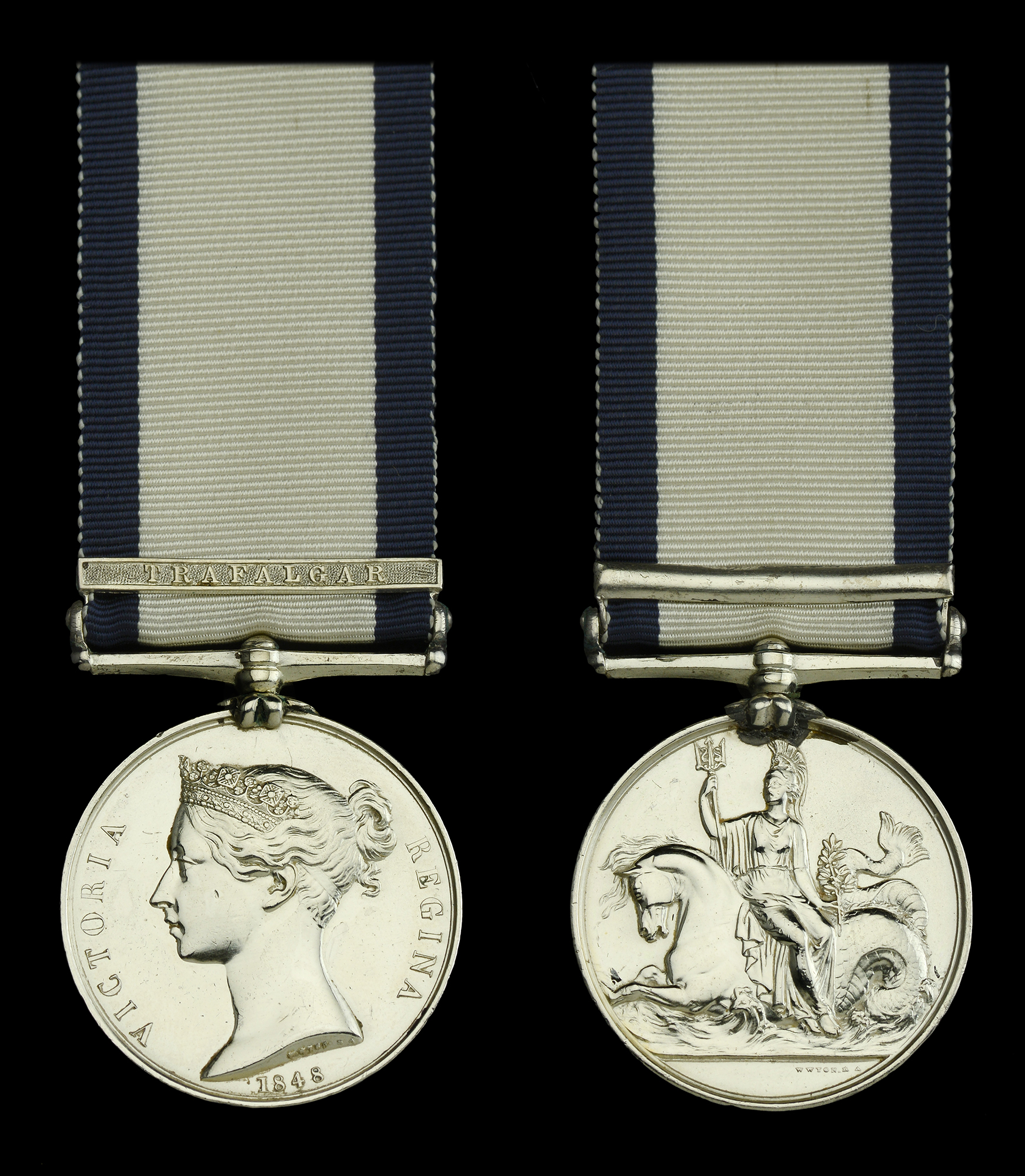The Naval General Service medal awarded to Rear-Admiral F. J. Thomas, Royal Navy, for his services as acting Lieutenant on board the Spartiate at the battle of Trafalgar; he afterwards performed valuable services at Cadiz and elsewhere on the coast of Spain, being promoted to Commander and thanked for his ‘patriotism, bravery, and zeal’ Naval General Service 1793-1840, 1 clasp, Trafalgar (F. I. Thomas, Act. Lieut. R.N.) engraved correction to initials, cleaned, otherwise good very fine £8,000-£10,000 --- Importation Duty This lot is subject to importation duty of 5% on the hammer price unless exported outside the UK --- --- Provenance: Dix Noonan Webb, June 2000. 88 clasps for Trafalgar issued to H.M.S. Spartiate. In the weather column Spartiate fought under Sir Francis Laforey in the great victory of Trafalgar, her losses amounting to five killed and twenty wounded. The Minotaur and Spartiate were the two rearmost ships in the weather column, but exchanged broadsides with several of the combined fleet. They managed to cut off the Spanish 84-gun ship Neptune, of which they contrived to get alongside, and which, after a fight of over an hour, surrendered. The Spartiate had her foretopsail yard shot away, and her masts, yards, and rigging in general were a good deal damaged (The Trafalgar Roll by R. H. Mackenzie refers). Frederick Jennings Thomas was born in the New Forest, Hampshire, on 19 April 1787, younger son of Sir John Thomas of Wenvoe Castle, Glamorgan. He entered the navy in March 1799, as First Class Volunteer on board the Boston, on the American and West India station, serving in that ship, as Midshipman and Master’s Mate, until August 1803. During that period he proved a volunteer on every occasion that involved difficulty or danger. In one instance, while conducting a valuable prize to Bermuda, he thwarted a plan laid by the greatly superior number of prisoners for re-taking the vessel. In September 1803 he joined the Prince of Wales, bearing the flag of Sir Robert Calder, and took part in the action fought on 22 July, 1805, with the combined fleets of France and Spain off Cape Finisterre. He was nominated Acting Lieutenant of the Spartiate on 19 September, and on 21 October, shared in the glories of Trafalgar. His appointment to the Spartiate being confirmed in February 1806, he served in her off Rochefort, and in the Mediterranean where he assisted at the blockade of Toulon, in the defence of Sicily, and a variety of operations on the coast of Italy, until November 1809. In December 1809 he joined the Antelope, bearing the flag of Sir John Thomas Duckworth, in which he conveyed His Britannic Majesty’s Ambassador to Cadiz. On his arrival there, Thomas succeeded, although the French army had surrounded the city, in obtaining information on their movements in the interior of Andalusia, which proved of advantage to the interests of Spain, and was forwarded by him to the British government. He also, at imminent hazard, made a survey of the enemy’s lines and fortifications, which he communicated in a chart to Lord Mulgrave, First Lord of the Admiralty, whose thanks he received in return. Continuing at Cadiz, Thomas was enabled to furnish government with the first information of the enemy’s intention of attacking the valuable fortresses of Tarifa and Cueta. While successfully engaged with a detachment of armed vessels, he boarded, and after a desperate resistance, retook two valuable Spanish ships which had been beguiled by the French under their batteries. In towing these from the shore he was for four hours exposed to a galling fire. He was subsequently presented with the thanks of the merchants of Cadiz in a gold box for his ‘energy and personal risk in defence of the trade.’ In an unsuccessful attack made in October 1810 by the troops under Lord Blayney on the castle of Frangerola, the gun-boat he was in was sunk after an action of two hours, and he himself wounded. Nevertheless he landed and remained with the army, still engaged with the enemy, until obliged to retire on board the Rambler. For his conduct he received the thanks of the Commander-in-Chief, was awarded a second promotal commission, and appointed second-in-command of the flotilla. On 5 July 1811, he made a valiant but ineffectual attempt to capture a French armed schooner in the River Guadalquivir. He subsequently, having volunteered his services, bore an important part in the expulsion of the French from Seville and, in about August 1812, became senior commander of the flotilla. During his service on the coast of Spain he was at the storming of twelve batteries, at the spiking or capture of several hundred pieces of ordnance, and at the capture and destruction of some 150 sail of vessels. Towards the end of 1813 he was acting Captain of the San Juan, flagship of Rear-Admiral Linzee at Gibraltar, and returned to England with Linzee in the Eurotas in 1814. His post rank having been confirmed in December 1813, he had no further employment afloat and, having married in 1816, settled in the neighbourhood of Southampton. He accepted the retired rank of Rear-Admiral on 1 October 1846, and died at Hill, near Southampton, on 19 December 1855.





